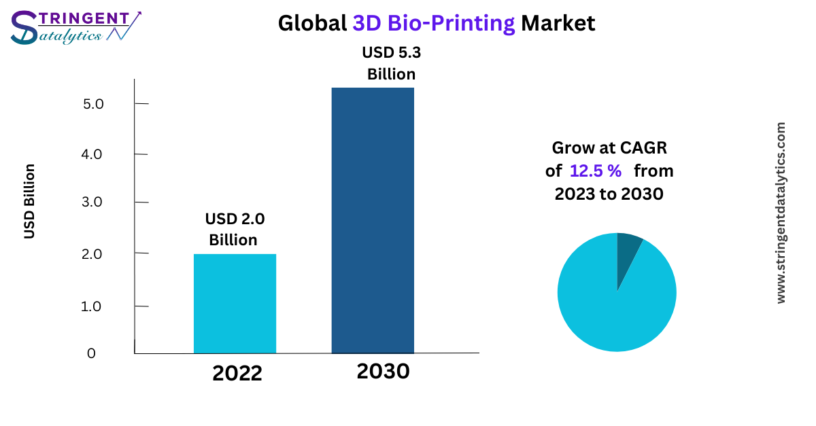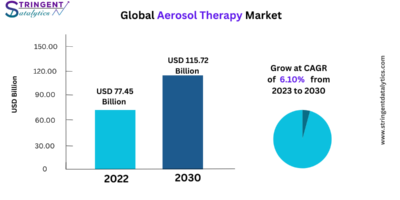3D Bio-Printing Market size was valued at USD 2.0 billion in 2022, is projected to reach USD 5.3 billion by 2030 and growing at a compound annual growth rate (CAGR) of 12.5% from 2023 to 2030.
The 3D bioprinting market involves the use of 3D printing technology to create complex biological structures, such as tissues and organs, by layering living cells and biomaterials. This technology holds promise for advancements in regenerative medicine, drug testing, and personalized medicine. The market is driven by the increasing demand for organ transplants, advancements in 3D printing technology, and the growing focus on personalized medicine and tissue engineering.
Key Components and Aspects of the 3D Bio-Printing Market:
- Applications:
- Tissue Engineering: Creating tissues for regenerative medicine and research purposes.
- Organ Transplantation: Developing functional organs for transplantation, addressing organ shortage issues.
- Drug Testing and Development: Producing human-like tissues for testing drug efficacy and toxicity.
- Personalized Medicine: Customizing medical treatments based on individual biological characteristics.
- Cancer Research: Creating tumor models for studying cancer progression and testing therapies.
- Market Drivers:
- Advancements in 3D Printing Technology: Improved printing techniques, materials, and software enhance the precision and functionality of bioprinted structures.
- Growing Demand for Organ Transplants: Increasing incidence of organ failure and the shortage of donor organs drive the need for alternatives.
- Rising Focus on Personalized Medicine: Tailoring treatments to individual patients’ needs, improving outcomes and reducing adverse effects.
- Supportive Government Initiatives: Funding and regulatory support for research and development in tissue engineering and regenerative medicine.
- Increasing Research and Development Activities: Ongoing research to improve the viability and functionality of bioprinted tissues and organs.
- Market Challenges:
- Complexity of Biological Systems: Replicating the intricate structures and functions of human tissues and organs remains challenging.
- Regulatory and Ethical Issues: Ensuring safety, efficacy, and ethical considerations in the use of bioprinted tissues and organs.
- High Cost of Equipment and Materials: Significant investment required for 3D bioprinting technology and materials.
- Limited Availability of Biomaterials: Developing suitable biomaterials that mimic the properties of natural tissues.
- Technical Limitations: Challenges in vascularization, cell viability, and long-term functionality of bioprinted structures.
- Regional Insights:
- North America: Largest market due to advanced healthcare infrastructure, significant R&D investment, and supportive regulatory environment.
- Europe: Strong market presence with extensive research initiatives, government support, and collaboration between academia and industry.
- Asia-Pacific: Rapidly growing market driven by increasing healthcare expenditure, expanding research capabilities, and rising awareness.
- Latin America and Middle East & Africa: Emerging markets with improving research infrastructure and growing focus on regenerative medicine.
- Key Players in the Market: Prominent companies in the 3D bioprinting market include Organovo Holdings, Inc., CELLINK, EnvisionTEC GmbH, Allevi, Inc., Aspect Biosystems Ltd., Cyfuse Biomedical K.K., RegenHU, and 3D Bioprinting Solutions. These companies focus on developing innovative bioprinting technologies, strategic partnerships, and expanding their product portfolios.
Future Outlook: The 3D bioprinting market is expected to experience significant growth, driven by advancements in technology, increasing demand for organ transplants, and the growing focus on personalized medicine. The development of new biomaterials, improvements in printing techniques, and integration with other technologies such as artificial intelligence and robotics will further enhance market growth. Additionally, regulatory approvals and ethical considerations will play a crucial role in the successful commercialization and adoption of bioprinted tissues and organs.
Click Here, To Get Free Sample Report https://stringentdatalytics.com/sample-request/3d-bio-printing-market/14828/
Market Segmentations:
Global 3D Bio-Printing Market: By Company
Organovo
Cyfuse Biomedical
BioBots
Luxexcel Group
Aspect Biosystems
3Dynamics Systems
Stratasys
Voxeljet
Materialise
Solidscape
Global 3D Bio-Printing Market: By Type
Magnetic Levitation
Inkjet Based 3D Bioprinting
Syringe Based 3D Bioprinting
Laser Based 3D Bioprinting
Others
Global 3D Bio-Printing Market: By Application
Medical
Dental
Biosensors
Food and Animal Product Bioprinting
Others
Global 3D Bio-Printing Market: Regional Analysis
The regional analysis of the global 3D Bio-Printing market provides insights into the market’s performance across different regions of the world. The analysis is based on recent and future trends and includes market forecast for the prediction period. The countries covered in the regional analysis of the 3D Bio-Printing market report are as follows:
North America: The North America region includes the U.S., Canada, and Mexico. The U.S. is the largest market for Cold-chain Pharma in this region, followed by Canada and Mexico. The market growth in this region is primarily driven by the presence of key market players and the increasing demand for the product.
Europe: The Europe region includes Germany, France, U.K., Russia, Italy, Spain, Turkey, Netherlands, Switzerland, Belgium, and Rest of Europe. Germany is the largest market for Cold-chain Pharma in this region, followed by the U.K. and France. The market growth in this region is driven by the increasing demand for the product in the automotive and aerospace sectors.
Asia-Pacific: The Asia-Pacific region includes Singapore, Malaysia, Australia, Thailand, Indonesia, Philippines, China, Japan, India, South Korea, and Rest of Asia-Pacific. China is the largest market for Cold-chain Pharma in this region, followed by Japan and India. The market growth in this region is driven by the increasing adoption of the product in various end-use industries, such as automotive, aerospace, and construction.
Middle East and Africa: The Middle East and Africa region includes Saudi Arabia, U.A.E, South Africa, Egypt, Israel, and Rest of Middle East and Africa. The market growth in this region is driven by the increasing demand for the product in the aerospace and defense sectors.
South America: The South America region includes Argentina, Brazil, and Rest of South America. Brazil is the largest market for Cold-chain Pharma in this region, followed by Argentina. The market growth in this region is primarily driven by the increasing demand for the product in the automotive sector.
Click Here, To Buy Premium Report https://stringentdatalytics.com/purchase/3d-bio-printing-market/14828/?license=single
Reasons to Purchase this Market Report:
- The competitive environment includes the proportions of important players, recent innovations, and strategy.
- Companies with extensive product offerings, pertinent financial data, recent advancements, SWOT analyses, and player tactics.
- Quantitative, qualitative, value (in USD million), and volume (in units million) data are among the segments and sub-segments.
- The research contains a wealth of data, including market dynamics and opportunities throughout the forecast period.
- Data at the regional, sub-regional, and national levels also provides information on the market’s supply and demand dynamics.
About Stringent Datalytics
Stringent Datalytics offers both custom and syndicated market research reports. Custom market research reports are tailored to a specific client’s needs and requirements. These reports provide unique insights into a particular industry or market segment and can help businesses make informed decisions about their strategies and operations.
Syndicated market research reports, on the other hand, are pre-existing reports that are available for purchase by multiple clients. These reports are often produced on a regular basis, such as annually or quarterly, and cover a broad range of industries and market segments. Syndicated reports provide clients with insights into industry trends, market sizes, and competitive landscapes. By offering both custom and syndicated reports, Stringent Datalytics can provide clients with a range of market research solutions that can be customized to their specific needs.
Contact Us
Stringent Datalytics
Contact No- +1 346 666 6655
Email Id- sales@stringentdatalytics.com




Leave a Reply